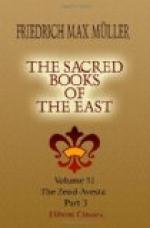In the year 1700, a professor at Oxford, Thomas Hyde, the greatest Orientalist of his time in Europe, made the first systematic attempt to restore the history of the old Persian religion by combining the accounts of the Mohammedan writers with “the true and genuine monuments of ancient Persia.” Unfortunately the so-called genuine monuments of ancient Persia were nothing more than recent Persian compilations or refacimenti. But notwithstanding this defect, which could hardly be avoided then, and a distortion of critical acumen, the book of Thomas Hyde was the first complete and true picture of modern Parsiism, and it made inquiry into its history the order of the day. A warm appeal made by him to the zeal of travellers, to seek for and procure at any price the sacred books of the Parsis, did not remain ineffectual, and from that time scholars bethought themselves of studying Parsiism in its own home.
Eighteen years later, a countryman of Hyde, George Boucher, received from the Parsis in Surat a copy of the Vendidad Sada, which was brought to England in 1723 by Richard Cobbe. But the old manuscript was a sealed book, and the most that could then be made of it was to hang it by an iron chain to the wall of the Bodleian Library, as a curiosity to be shown to foreigners. A few years later, a Scotchman, named Fraser, went to Surat, with the view of obtaining from the Parsis, not only their books, but also a knowledge of their contents. He was not very successful in the first undertaking, and utterly failed in the second.
In 1754 a young man, twenty years old, Anquetil Duperron, a scholar of the Ecole des Langues Orientales in Paris, happened to see a fac-simile of four leaves of the Oxford Vendidad, which had been sent from England, a few years before, to Etienne Fourmont, the Orientalist. He determined at once to give to France both the books of Zoroaster and the first European translation of them. Too impatient to set off to wait for a mission from the government which had been promised to him, he enlisted as a private soldier in the service of the French East India Company; he embarked at Lorient on February 24, 1755, and after three years of endless adventures and dangers through the whole breadth of Hindostan, at the very time when war was waging between France and England, he arrived at last in Surat, where he stayed among the Parsis for three years more. Here began another struggle, not less hard, but more decisive, against the same mistrust and ill-will which had disheartened Fraser; but he came out of it victorious, and prevailed at last on the Parsis to part both with their books and their knowledge. He came back to Paris on March 14, 1764, and deposited on the following day at the Bibliotheque Royale the whole of the “Zend-Avesta,” and copies of several traditional books. He spent ten years in studying the material he had collected, and published in 1771 the first European translation of the “Zend-Avesta.”




